Osteochondrosis of the spine of the cervix appears due to pathological changes in interfaced discs. They weaken, become thinner, lose elasticity, cease to protect vertebrae from damage and lose their ability to provide them with sufficient mobility. The main danger of cervical osteohondrosis is that the disease affects the nerve endings of the spinal region, which is due to the brain blood injury.

Types and classification
There is a variety of stages of osteochondrose of cervix:
- First: initial changes in the intervertebral disk cartilage fabric;
- Second: Start of disk thinning, reduction between vertebrae;
- Third: Disk destruction, the beginning of the spine deformation;
- Fourth: Stronger deformation.
Causes
The main cause of cervix is in the structure of the spine in this area. All spines fit tight here and move easily even with a minor load.
Given how many mobile cervical regions, it is not surprising that the disease is so widespread.
Causes the start of the disease:
- Congenital anatomical characteristics (in people with a long neck, osteochondrose often occur);
- Breach of the digestibility of minerals;
- Hormonal deviations;
- Lack of sufficient muscle corset in the neck and shoulders;
- hypodynamia;
- cervical injuries;
- hypothermia;
- Holding disorders;
- Excess weight.

Symptoms
- It is often the first symptom of cervical osteochondrose headaches. It can be very strong, striving like migraines, accompanied by dizziness and lunatic.
- The appearance of "flies", dark spots, blurry in front, and the vision decrease is characteristic.
- The neck pain with this disease gives the back of the head, forehead, ears, intensifies when the head position changes.
- It is often noted with a stiffness of your hands.
- There is noise in the ears, hearing loss.
- Violation of the coordination of movement may occur obscen.
Diagnostics
To identify osteochondrose of cervix, they implement:
- a radiography that determines the state of vertebrae;
- calculated tomography, to identify disk damage;
- Dopplerography that establishes blood flow disruptions;
- Duplex scan shows the state of blood vessels.
Treatment
As an ambulance for cervical osteochondrose, pain medications and anti-alflamatory drugs are needed. Depending on the strength of pain syndrome, local medications (fats and gels), tablets or injections are used.

Also appointed:
- Vitamin therapy (vitamins of Group B);
- medications that relieve muscle cramp,
- Chondroprotector;
- Physiotherapy procedures (electrophoresis, paraffin, magnetotherapy and others);
- Medical gymnastics;
- Massage and self-consideration.






















